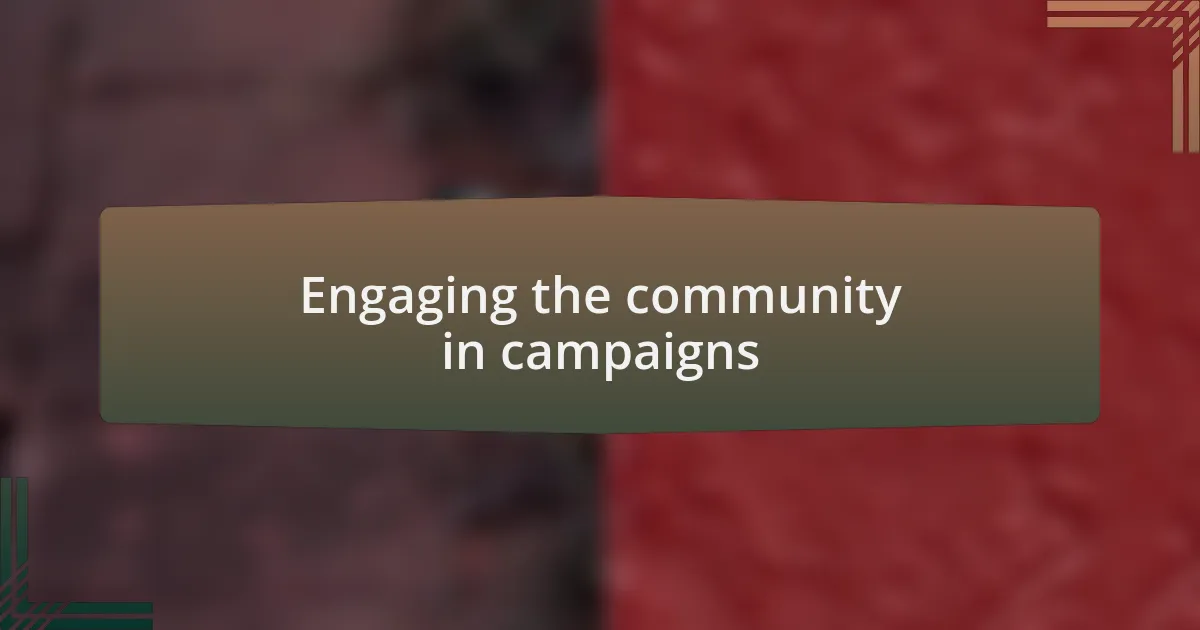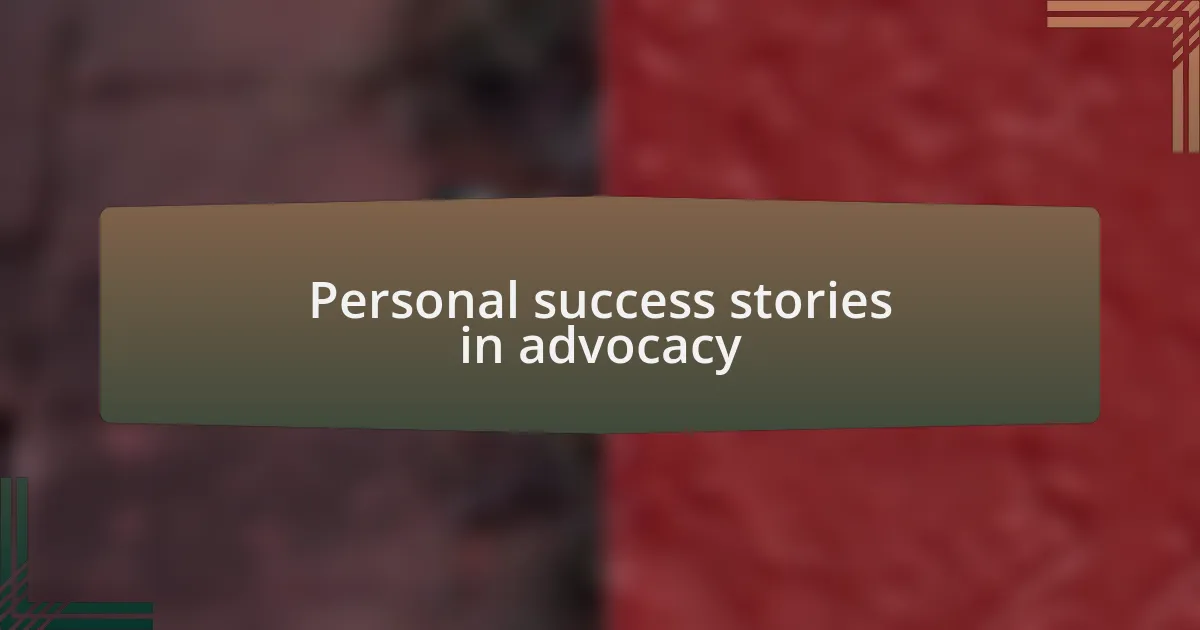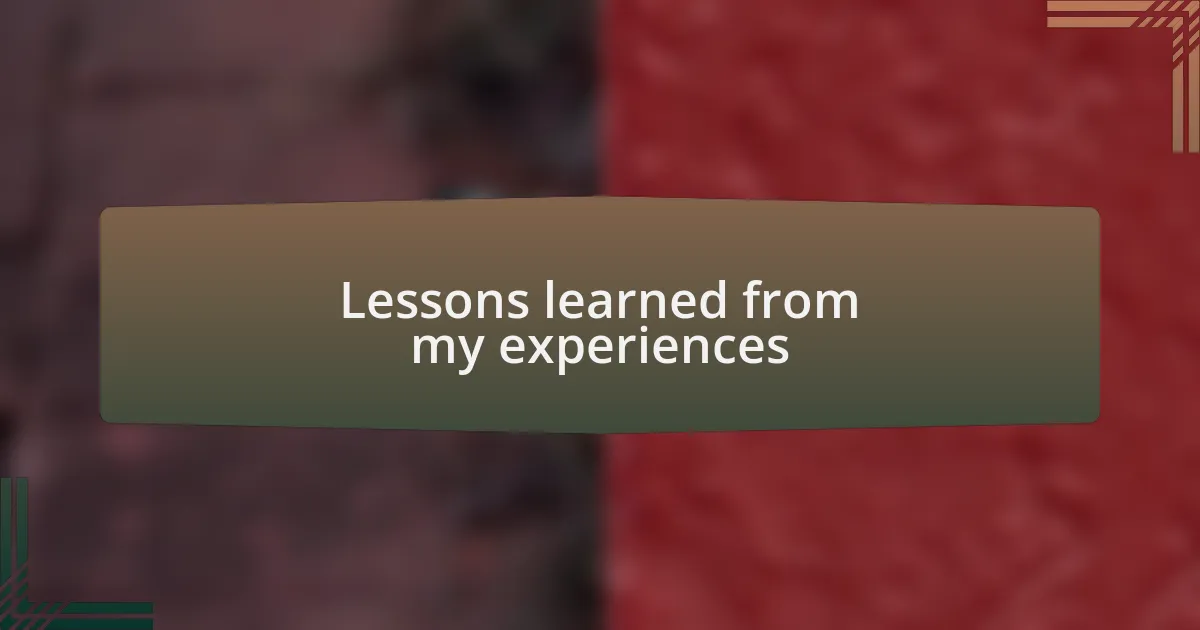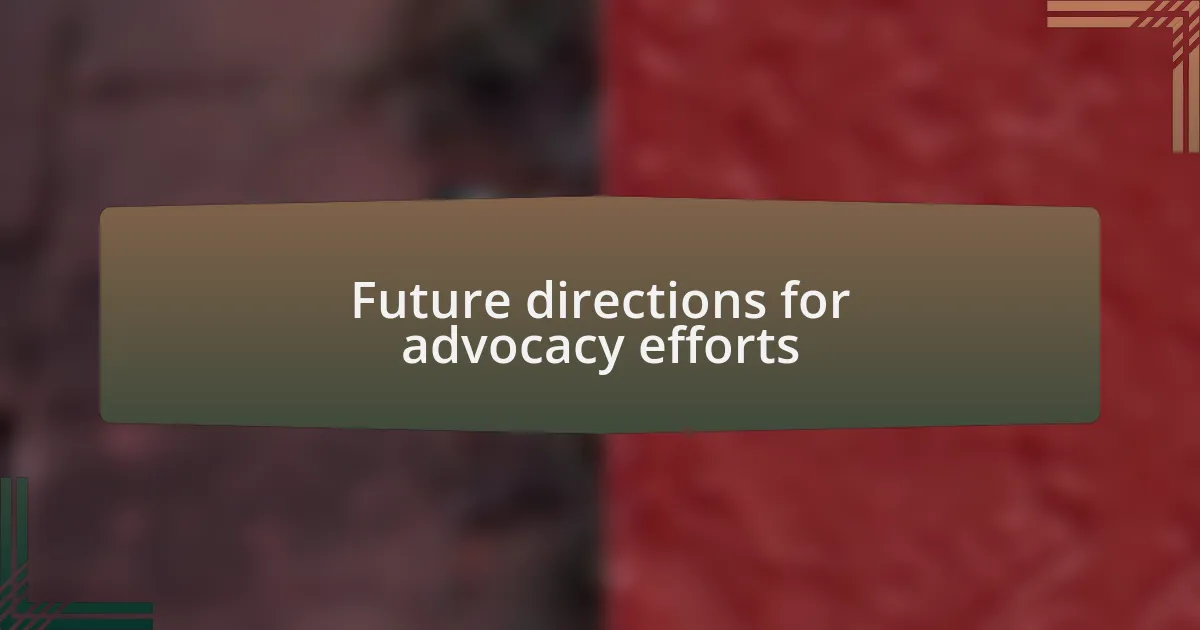Key takeaways:
- Habitat preservation and biodiversity advocacy are crucial for butterfly conservation, emphasizing the importance of ecosystem health.
- Effective advocacy combines community engagement, storytelling, and social media to inspire action and amplify messages about conservation.
- Personal success stories in advocacy highlight the power of grassroots efforts, data sharing, and emotional connections in fostering community involvement.
- Looking ahead, leveraging technology, collaborating with educational institutions, and refining messaging to resonate emotionally will drive future advocacy efforts.

Understanding butterfly conservation goals
Butterfly conservation goals are rooted in the desire to protect not only these beautiful creatures but also the ecosystems they inhabit. I often think about the fragile balance of nature when I witness a vibrant butterfly flitting from flower to flower—it’s a reminder that their survival signifies a healthy environment. Have you ever wondered how our actions can directly influence their fate?
One main goal is habitat preservation. I remember volunteering at a local nature reserve, where we worked tirelessly to restore a meadow. Seeing the butterflies return to that space was an unforgettable experience, and it underscored how essential it is to maintain their natural habitats. The connection between land management and butterfly populations is vital, and awareness around this issue is an important step toward achieving conservation goals.
Another significant aspect is advocating for biodiversity. In my experience, when people grasp the interdependence of species, they become more passionate about protecting them. Isn’t it fascinating how one butterfly can serve as a pollinator for many plants? Reflecting on these connections often deepens my commitment to conservation, as every effort counts in supporting these delicate networks.

Importance of advocacy in conservation
Advocacy plays a crucial role in conservation efforts, serving as a bridge between scientific knowledge and public awareness. I still recall a local campaign I participated in, where we mobilized the community to rally for stricter pesticide regulations. Watching people come together, motivated by a shared love for butterflies, reinforced my belief that advocacy can effectively drive change and protect vital habitats.
The emotional connection people feel towards butterflies can transform into a powerful force for conservation. I remember a moment during a butterfly release event, seeing the joy on children’s faces as they set the butterflies free. It’s moments like these that remind me how advocacy is more than just facts and figures; it’s about creating a movement that resonates with people’s hearts and inspires action.
Moreover, advocacy expands the conversation around conservation, drawing in diverse voices and perspectives. As I engaged with farmers about sustainable practices, I found that many were unaware of the positive impact their choices could have on butterfly populations. This experience highlighted how advocacy can open doors to dialogue, fostering collaboration that enriches our collective efforts to protect these incredible creatures.

Strategies for effective advocacy campaigns
One effective strategy for advocacy campaigns is building relationships within your community. I once collaborated with local schools to create butterfly gardens, which not only beautified the area but educated students about conservation. I saw firsthand how these connections sparked curiosity and enthusiasm in young minds, proving that grassroots efforts can lead to profound impacts on public awareness.
Utilizing storytelling is another powerful approach. During a recent campaign, I shared the story of a butterfly species on the brink of extinction due to habitat loss—a narrative that moved people to act. Have you ever noticed how stories make facts more relatable? When we weave personal experiences and emotional appeals into our messaging, we can inspire others to join our cause, making the issue feel urgent and personal.
Lastly, leveraging social media effectively can amplify any advocacy effort. I remember launching a campaign hashtag that went viral, connecting people across the globe who shared a passion for butterfly conservation. This experience made me realize how important it is to harness digital platforms to engage a wider audience—what tools are you using to spread your message? The online community can be a catalyst for change, rallying support and fostering connections that were once unimaginable.

Engaging the community in campaigns
Engaging the community in campaigns requires a hands-on approach that resonates deeply with local interests. I recall hosting a community workshop where residents could create their own butterfly-friendly spaces in their backyards. The excitement in the room was palpable as people shared their ideas and experiences, which reinforced the idea that conservation is not just a goal, but a shared journey we can embark on together. Have you ever noticed how a little hands-on activity can turn casual interest into passionate involvement?
Involving local artists can also enhance community engagement in unique ways. During an advocacy project, we organized a mural contest that celebrated local butterfly species, transforming a dull wall into a vibrant expression of conservation passion. The resulting artwork became a community landmark, sparking conversations and curiosity about butterfly habitats. How often do you see art awakening new ideas and connections in your community?
Additionally, hosting themed events around significant dates can bolster engagement significantly. For instance, on World Wildlife Day, I partnered with local businesses for a butterfly festival that featured educational booths, live music, and butterfly releases. The festival drew people from all walks of life, igniting a sense of community pride while spreading awareness about conservation. Have you experienced the magic of uniting different voices for a common cause? These shared moments create lasting memories and inspire ongoing commitment to advocacy efforts.

Personal success stories in advocacy
One of my favorite success stories in advocacy revolves around an unexpected partnership I formed with a local school. We created a butterfly garden together, and the kids were absolutely thrilled to participate. Watching their eyes light up as they planted flowers that would attract butterflies was genuinely heartwarming. Have you ever seen the pure joy of a child realizing they can make a difference? It reminded me that advocacy can start small but have immense ripple effects.
Another moment that stands out was when I collected data on butterfly populations in my area. I shared these findings at a town hall meeting, which sparked a robust discussion about land management practices. People were visibly moved when we connected the dots between butterfly health and their own environments. How often do we overlook the simple facts that can drive change? This experience taught me the power of data in advocacy; it can illuminate problems and galvanize the community towards action.
I also recall a late-night session working on a social media campaign aimed at raising awareness about endangered butterfly species. It was exhausting, but when the post went viral, I felt an overwhelming sense of accomplishment. The comments and shares flooded in, and it was incredibly gratifying to see the community rally around something so vital. Have you ever felt the adrenaline surge when your hard work pays off in ways you never imagined? That moment reinforced my belief that advocacy isn’t just about the work we put in; it’s about the momentum we can create when others join us on the journey.

Lessons learned from my experiences
A major lesson I’ve learned is the importance of storytelling in advocacy. I once gave a talk at a community event about the migration patterns of our local butterflies. My aim was to inform, but I found that sharing personal tales of watching these butterflies as a child truly engaged the audience. Ever experienced that moment when your personal story resonates with someone? It was in that connection that I realized stories bridge understanding and inspire action.
Reflecting on my campaign efforts, I also recognized the value of listening to diverse voices in the community. I hosted a roundtable where people shared their views on local habitats. While some were skeptical about the role of butterflies in our ecosystem, the conversations opened up new ideas and collaborations. Have you ever thought about how listening can lead to unexpected pathways? This experience taught me that advocacy thrives not just on speaking out, but on cultivating dialogue.
Lastly, I’ve come to appreciate the necessity of celebrating all victories, no matter how small. I remember the thrill of reaching a fundraising goal for our butterfly habitat restoration project. While it might seem minor to some, I celebrated it with my team because it represented collective effort and hope. How often do we stop to recognize the little wins? Each small achievement adds up, showcasing that every step taken in advocacy counts towards the bigger picture.

Future directions for advocacy efforts
Looking ahead in advocacy, I believe that harnessing technology will be crucial. I remember when I first used social media to rally support for a butterfly conservation event. The immediate responses from people sharing their own experiences made me realize how digital platforms can amplify our messages. Have you ever felt the power of a single tweet or post creating a wave of support? This engagement makes technology not just a tool, but a partner in our advocacy efforts.
In addition, I envision a future where collaborations with schools and educational institutions are pivotal. A colleague once organized a workshop at a local school, and seeing the students enthusiastically learn about butterflies was inspiring. How can we inspire the next generation if we don’t actively engage them today? I believe that involving young minds will not only bolster our current efforts but also ensure that the importance of conservation will continue to be championed for years to come.
Lastly, I think it’s essential that we refine our messaging to connect deeply with emotional values. During a local event, I posed a question to the audience: “What does nature mean to you?” The heartfelt responses underscored how individual emotions can ignite a collective passion for butterflies. Isn’t it fascinating how a simple question can unveil so much about our relationship with nature? Going forward, I want to harness these emotional connections to strengthen our advocacy campaigns.